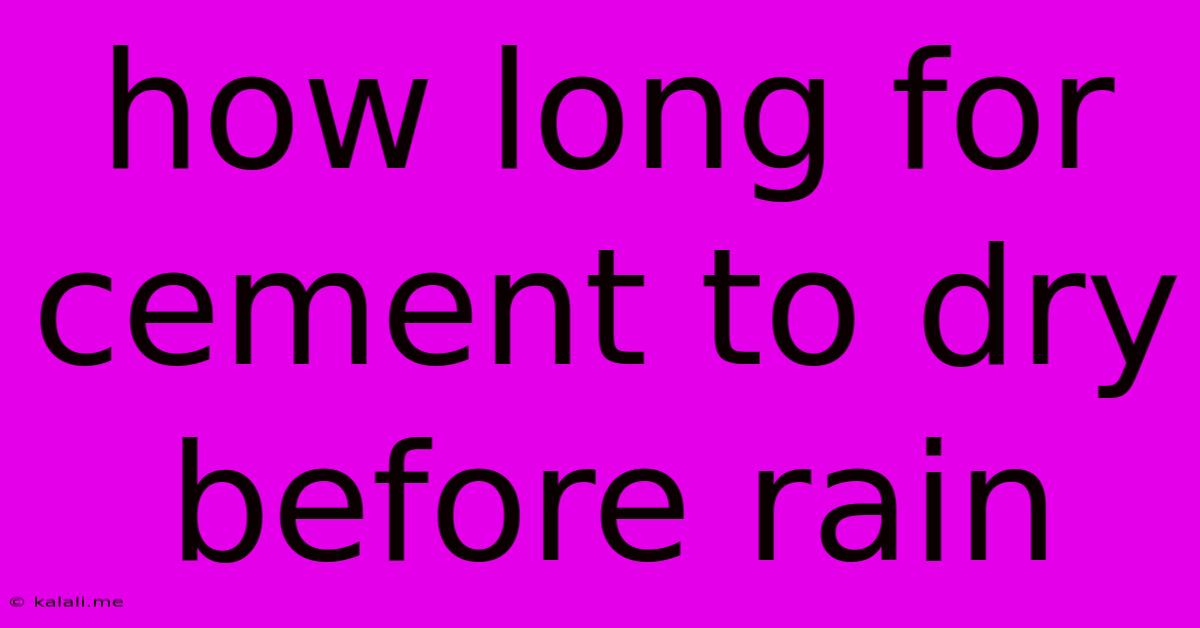How Long For Cement To Dry Before Rain
Kalali
May 21, 2025 · 4 min read

Table of Contents
How Long Does Cement Need to Dry Before Rain? A Comprehensive Guide
Meta Description: Worried about rain ruining your fresh cement work? Learn how long cement needs to dry before it's safe from rain damage and how to protect it. This guide covers curing times and essential protection tips.
Pouring concrete is a significant undertaking, whether you're crafting a patio, laying a foundation, or simply fixing a cracked walkway. A crucial factor impacting the longevity and integrity of your cement work is protection from rain. But how long does cement actually need to dry before it's safe from a downpour? The answer isn't a simple number, and it depends on several factors. This guide delves into the intricacies of cement drying time and provides actionable steps to protect your investment.
Understanding the Cement Drying Process: More Than Just Drying
It's important to understand that the process isn't simply "drying." Cement doesn't dry; it cures. Curing is a chemical process where the cement powder reacts with water, creating a hard, durable material. This process involves hydration – a chemical reaction – and requires specific conditions to occur optimally. Simply letting the water evaporate doesn't guarantee a strong, long-lasting concrete surface.
Factors Affecting Cement Curing Time
Several factors significantly influence how long your cement needs to cure before it can withstand rain without damage:
-
Type of Cement: Different cement mixes have varying curing times. Quick-setting cement, for example, will cure faster than standard Portland cement.
-
Thickness of the Pour: Thicker pours require longer curing times because the water needs more time to hydrate the cement throughout the entire depth.
-
Temperature and Humidity: Warmer temperatures generally speed up the curing process, while cooler temperatures slow it down. High humidity can also prolong the curing time.
-
Air Circulation: Good air circulation helps to regulate temperature and moisture levels, promoting even curing.
-
Mix Ratio: The water-to-cement ratio directly impacts the curing time and the final strength of the concrete. Too much water can weaken the concrete and prolong curing.
How Long to Wait Before Rain Exposure?
While there's no single magic number, a general guideline is to protect your fresh cement pour from rain for at least 24 hours. However, for optimal strength and durability, it's best to protect it for 3 to 7 days, depending on the factors mentioned above. The longer you protect it, the stronger and more resistant to weathering it will become. After 7 days, the concrete will have significantly hardened and is less vulnerable to damage from rainfall.
Protecting Your Cement from Rain
Several methods can protect your cement from rain:
-
Tarping: Covering the poured cement with a heavy-duty tarp is a highly effective method. Ensure the tarp is securely fastened to prevent it from blowing away in strong winds.
-
Plastic Sheeting: A less expensive option is using plastic sheeting, although it's less durable and may require more secure fastening.
-
Curing Compounds: These are specialized liquid or membrane products applied to the surface to help retain moisture and aid in curing.
-
Water Spraying (Curing): Keeping the surface consistently moist (not soaked) through regular spraying helps maintain hydration during the curing process, especially in hot, dry climates.
Consequences of Rain Exposure
Rain during the initial curing period can lead to several problems:
-
Reduced Strength: Rain can wash away essential cement particles, weakening the final structure.
-
Surface Damage: Rain can create surface imperfections and pitting, reducing the aesthetic appeal.
-
Cracking: Rapid drying caused by rain can lead to cracks in the cement, compromising its integrity.
-
Longer Curing Time: Rain can prolong the curing process, delaying the time before you can use or walk on the concrete.
Conclusion
Protecting your fresh cement pour from rain is crucial for ensuring its strength, durability, and longevity. While 24 hours is a minimum, aiming for at least 3 to 7 days of protection, using methods like tarps, plastic sheeting, or curing compounds, will significantly improve the quality of your cement work. Remember to consider the specific conditions and type of cement used to determine the best protection strategy. By following these guidelines, you can confidently tackle your concrete projects with the assurance of a long-lasting, rain-resistant result.
Latest Posts
Latest Posts
-
How To Run Electricity To A Shed
May 21, 2025
-
How Do You Feed A Horse On Minecraft
May 21, 2025
-
How Fast Can A Gorilla Run
May 21, 2025
-
Wiring Diagram For 2 Switches And 1 Light
May 21, 2025
-
How To Get Rid Of Diesel Smell
May 21, 2025
Related Post
Thank you for visiting our website which covers about How Long For Cement To Dry Before Rain . We hope the information provided has been useful to you. Feel free to contact us if you have any questions or need further assistance. See you next time and don't miss to bookmark.